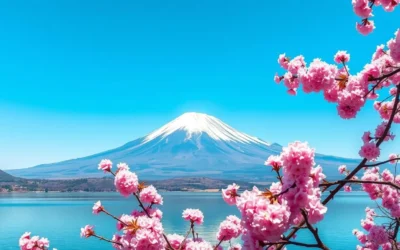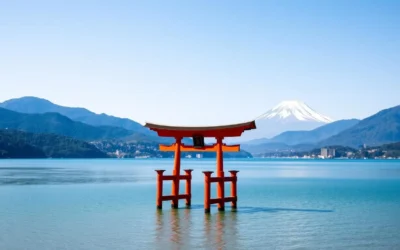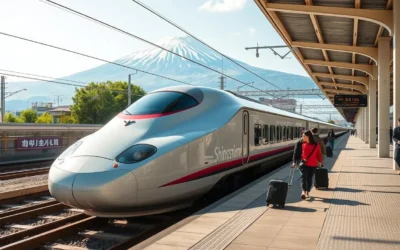✓ Accommodations✓ Flights✓ Rental Cars✓ Tours & Activities
Did you know Aomori City receives an astonishing 26 feet of snow annually, making it one of Japan’s snowiest cities? Yet despite this winter wonderland status, Aomori draws over 3 million visitors during its vibrant Nebuta Festival alone. This northernmost prefecture capital on Japan’s main island offers a perfect blend of cultural richness, natural beauty, and culinary delights that remain surprisingly undiscovered by many international travelers.
Getting to Aomori City
Reaching this northern gem is easier than you might expect. Aomori Airport connects to major Japanese cities with daily flights from Tokyo (90 minutes), Osaka, and Sapporo. Alternatively, the high-speed Shinkansen bullet train reaches Shin-Aomori Station from Tokyo in about 3 hours, offering spectacular countryside views along the way.
Ready to Explore Aomori?
Find the best flight deals to start your Aomori adventure!
Aomori City’s stunning bay area with the iconic Bay Bridge
Best Time to Visit Aomori City
Aomori’s appeal transforms dramatically with the seasons, each offering unique experiences:
Summer (June-August)
The prime season for visitors, highlighted by the spectacular Nebuta Festival in early August. Temperatures are pleasant, ranging from 68-82°F (20-28°C), perfect for exploring outdoor attractions. This is also when the region’s famous apple orchards begin to flourish.
Autumn (September-November)
A magical time when the surrounding mountains explode with vibrant fall colors. The Hakkoda Mountains and Oirase Gorge become particularly stunning. Temperatures cool to 45-65°F (7-18°C), and the apple harvest season brings fresh produce and special apple-themed dishes throughout the city.
Winter (December-February)
Aomori transforms into a snow paradise with some of Japan’s heaviest snowfall. Winter sports enthusiasts flock to nearby ski resorts, while the city hosts beautiful snow lantern festivals. Temperatures range from 23-36°F (-5 to 2°C), so pack accordingly!
Spring (March-May)
As snow melts, the region comes alive with cherry blossoms, particularly at nearby Hirosaki Castle Park (late April to early May). Spring temperatures range from 41-65°F (5-18°C), and crowds are smaller than during summer festivals.

The spectacular Nebuta Festival illuminates Aomori’s summer nights
Getting Around Aomori City
Aomori City is compact enough to navigate easily, with several transportation options to help you explore:
Explore Beyond the City
Rent a car to discover Aomori’s breathtaking countryside at your own pace.
Where to Stay in Aomori City
Aomori offers accommodations for every budget and preference, from modern hotels to traditional Japanese inns:
City Center Hotels
Stay near Aomori Station for convenience to transportation and dining. The Richmond Hotel Aomori and Hotel JAL City Aomori offer comfortable rooms with modern amenities and easy access to the Nebuta Museum and A-Factory.
Bay Area Accommodations
Properties like the Aomori Center Hotel and ReLabo Spa&Stay offer stunning bay views and are within walking distance to the waterfront attractions. Many feature onsen baths and excellent seafood restaurants.
Traditional Ryokans
For an authentic Japanese experience, stay at a ryokan like Sukayu Onsen, dating back to 1929. Located in the Hakkoda Mountains (about an hour from the city), it offers traditional tatami rooms, communal baths, and kaiseki dining.
Find Your Perfect Stay in Aomori
Browse accommodations ranging from modern hotels to traditional ryokans.

Experience traditional Japanese hospitality at an authentic ryokan with onsen
Top Attractions in Aomori City Japan
From cultural museums to natural wonders, Aomori offers diverse experiences for every traveler:
1. Nebuta Museum Wa-Rasse
This striking waterfront museum showcases the massive, illuminated floats from Aomori’s famous Nebuta Festival. The museum’s unique architecture resembles a lantern, and inside you’ll find impressive floats depicting warriors, gods, and mythological creatures. Interactive exhibits explain the festival’s 300-year history and the painstaking process of creating these paper masterpieces. Don’t miss the taiko drumming performances held several times daily.

The spectacular Nebuta floats on display at Wa-Rasse Museum
Experience Nebuta Culture
Book a guided tour of the Nebuta Museum and other Aomori highlights.
Book Guided Tour
2. A-Factory
Located next to the Nebuta Museum, this modern complex celebrates Aomori’s status as Japan’s top apple-producing region. Inside, you’ll find a cidery, fresh produce market, and restaurants featuring local ingredients. The second floor houses a unique self-serve cider tasting system where you can sample various apple ciders. Don’t leave without trying the apple pie, apple soft cream, or purchasing some apple products as souvenirs.
3. Aomori Bay Bridge
This 1,219-meter bridge spanning Aomori Bay offers spectacular views, especially when illuminated at night. Walking across provides excellent photo opportunities of the bay, city, and surrounding mountains. The bridge connects to the Aomori Bay Area, where you’ll find the former ferry Hakkoda Maru, now a maritime museum showcasing the region’s seafaring history.

The Aomori Bay Bridge beautifully illuminated against the night sky
4. Sannai-Maruyama Archaeological Site
Step back 5,500 years at Japan’s largest and best-preserved Jomon-period village. This UNESCO World Heritage site features reconstructed pit dwellings, longhouses, and raised-floor structures that provide insight into prehistoric Japanese life. The on-site museum displays pottery, tools, and artifacts excavated from the area. Located just 20 minutes by bus from Aomori Station, it’s a fascinating glimpse into Japan’s ancient past.

Reconstructed Jomon-period buildings at the Sannai-Maruyama Archaeological Site
Natural Wonders Around Aomori
Some of Aomori’s most breathtaking attractions lie just outside the city center:
5. Oirase Gorge
Just an hour from Aomori City, this picturesque river valley stretches 14km between Lake Towada and Yakeyama. The gentle hiking trail follows crystal-clear waters past numerous waterfalls, moss-covered rocks, and dense forests. Particularly stunning during autumn foliage season (late October), the gorge offers photographers countless opportunities for perfect shots. Even beginners can enjoy the mostly flat trail, with rest areas and cafes along the route.

The stunning autumn colors of Oirase Gorge make it a photographer’s paradise
6. Lake Towada
Japan’s largest crater lake on the main island offers breathtaking blue waters surrounded by forested mountains. Take a sightseeing boat cruise or, for the adventurous, a thrilling speedboat ride with Guriland that gets you closer to the shoreline cliffs. The eastern shore features the iconic “Statue of Maidens,” a symbol of the lake. Combined with Oirase Gorge, Lake Towada makes for a perfect day trip from Aomori City.
7. Hakkoda Mountains
This volcanic mountain range south of Aomori City is a paradise for outdoor enthusiasts in every season. Winter brings exceptional powder snow for skiing and the unique “snow monsters” – trees encased in wind-blown ice formations. Summer and autumn offer excellent hiking trails with panoramic views. The Hakkoda Ropeway provides easy access to the summit year-round, with spectacular views of the surrounding landscape.

The famous “snow monsters” of Hakkoda Mountains create an otherworldly winter landscape
Culinary Experiences in Aomori
Aomori’s cuisine celebrates the bounty of both sea and land, with several must-try specialties:
Nokkedon
Create your own seafood rice bowl at the Aomori Gyosai Center (Furukawa Fish Market). Purchase a ticket with 12 coupons, exchange one for rice, then visit different vendors to select fresh seafood toppings. It’s an interactive and delicious way to sample the region’s marine bounty for around ¥2000.
Apple Delicacies
As Japan’s apple capital, Aomori offers countless apple-themed treats. Try apple pie at A-Factory, apple soft cream (ice cream) near Lake Towada, apple cider, apple curry, and even apple-fed beef. The Fuji and Tsugaru varieties are particularly prized for their sweetness.
Hachinohe Bouillabaisse
During February and March, restaurants in Hachinohe (eastern Aomori Prefecture) compete in the Bouillabaisse Festa. This French-inspired seafood stew gets a Japanese twist, featuring at least four types of local seafood. Even outside festival season, some restaurants will prepare it upon request.

A colorful Nokkedon seafood bowl featuring Aomori’s fresh marine delicacies
Where to Eat
Unique Cultural Experiences
Immerse yourself in Aomori’s distinctive cultural offerings:
1. Soak in a Traditional Onsen
Sukayu Onsen, dating back over 300 years, features a massive “thousand-person bath” (sen-nin-buro) built entirely of cypress wood. It’s one of Japan’s few remaining mixed-gender baths, though there are separate facilities and scheduled women-only times. The alkaline waters are said to heal various ailments. Located in the Hakkoda Mountains, it’s perfect after hiking or skiing.

The historic “thousand-person bath” at Sukayu Onsen, built entirely of cypress wood
2. Ride the Winter Stove Train
For a nostalgic experience, take the Tsugaru Railway’s Stove Train that operates from December to March. This charming old train features a potbelly stove in the middle of the carriage where staff grill dried squid and warm sake for passengers. The train runs between Tsugaru Goshogawara and Tsugaru Nakasato stations, offering views of snow-covered countryside.
3. Visit a Sake Brewery
The Hachinohe Shuzo Sake Brewery, established in 1775, offers tastings and a glimpse into traditional sake production. While the factory itself isn’t open for tours, the adjacent tasting room allows visitors to sample various sake types. Look for the traditional sugidama (cedar ball) hanging outside, indicating a sake brewery.

Traditional sake barrels at a historic brewery in Aomori Prefecture
Seasonal Festivals and Events
Time your visit to coincide with one of Aomori’s spectacular festivals:
Nebuta Matsuri (August 2-7)
Aomori’s most famous festival features enormous illuminated paper floats depicting warriors, gods, and mythological creatures paraded through the streets. Accompanied by taiko drums, flutes, and dancers chanting “Rassera, rassera!” this energetic festival attracts over 3 million visitors. The final night concludes with a magnificent fireworks display over the bay.
Hirosaki Cherry Blossom Festival (Late April-Early May)
Just 40 minutes from Aomori City, Hirosaki Castle Park hosts one of Japan’s most beautiful cherry blossom displays, with over 2,600 trees creating tunnels of pink blossoms. The castle moat filled with petals creates magical “cherry blossom carpets” on the water.
Aomori Snow Lantern Festival (February)
Hundreds of small snow lanterns illuminate the winter darkness in this charming festival. Local residents and visitors create snow sculptures and lanterns, creating a magical winter wonderland atmosphere.
Hachinohe Sansha Taisai (July 31-August 4)
This 300-year-old festival in eastern Aomori Prefecture features elaborate dashi floats, traditional dance performances, and horseback archery demonstrations. The highlight is the parade of 27 floats through the city streets.

The stunning cherry blossoms of Hirosaki Castle Park, just a short trip from Aomori City
Practical Travel Tips
Weather Preparedness
Aomori’s weather can be extreme. Summer is pleasant but can be humid—pack light clothing and rain gear. Winter brings heavy snow—bring insulated waterproof boots, a heavy coat, gloves, and hat. Spring and fall require layers as temperatures can fluctuate significantly throughout the day.
Transportation Tips
Consider a JR East Pass (Tohoku area) if planning multiple train trips. For Lake Towada and Oirase Gorge, the one-day bus pass offers good value. In winter, use public transportation rather than driving unless you’re experienced with snow conditions. Taxis are readily available but have a surcharge after 10 PM.
Cultural Etiquette
Remove shoes when entering traditional ryokans, some restaurants, and homes. At onsens, wash thoroughly before entering the bath and never wear swimwear. Tipping is not customary in Japan. Learn basic Japanese phrases—even simple greetings are appreciated by locals.

Aomori’s legendary winter snowfall transforms the city into a winter wonderland
Aomori City is located at the northern tip of Honshu island
Experience the Magic of Aomori
From the pulsating energy of the Nebuta Festival to the serene beauty of Oirase Gorge, Aomori City offers a perfect blend of cultural richness and natural splendor that remains refreshingly authentic. Whether you’re savoring fresh seafood at the market, soaking in a centuries-old onsen, or marveling at illuminated festival floats, Aomori rewards visitors with experiences that can’t be found elsewhere in Japan. As one of the country’s last undiscovered treasures, now is the perfect time to explore this northern gem before the secret gets out. Your Aomori adventure awaits!
Ready to Discover Aomori?
Start planning your journey to northern Japan’s hidden gem today!
—
The above is subject to change.
Check back often to TRAVEL.COM for the latest travel tips and deals.






